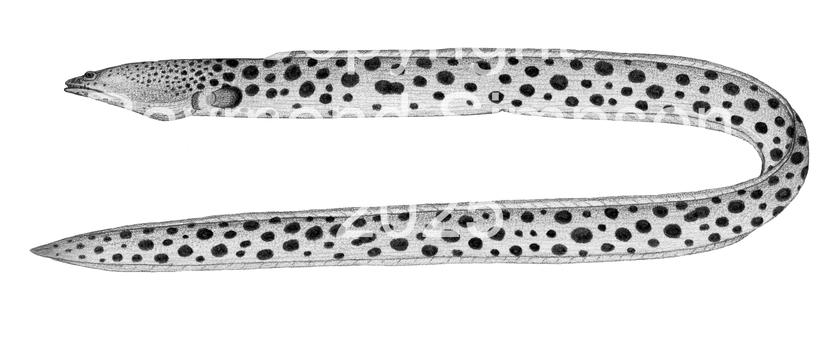
Common Name
Spotted Spoon-nose Eel
Year Described
Richardson, 1848
Identification
Vertebrae: 125-138 (53-58 pre-anal)
Body rather stout but elongated and cylindrical, with trunk longer than caudal region (52-57% TL). Snout short, narrowing anterior to eye, and distinctly down-curved (spoon-nosed eel). Eyes close to tip of snout and close together. Jaws fairly long and even (not underslung). Anterior nostril a short tube. Posterior nostril also tubular, outside of mouth, above lip, and anterior to lower eye. Teeth at front of upper jaw large (4-5). Two rows of maxillary teeth posteriorly (outer row of 14-26 larger and inner row of 8-14 tiny). Intermaxillary teeth present. Vomerine teeth strong (20-43 in two rows). Anterior lower jaw with 4-6 large teeth. Lower jaw teeth posteriorly in two rows with outer row larger. Gill slit vertical, low on side and immediately anterior to pectoral base. Body with conspicuous fine grooves. Dorsal and anal fins not confluent; tail tip a finless point (Ophichthinae). Dorsal fin origin behind pectoral tip by a distance less than pectoral length. Pectoral fins well developed and rounded. Body and head pores minute. Two small preopercular pores.
Color
Body cream dorsally and white ventrally, with 1-4 rows of large dark blotches (larger than eye to the size of pectoral fin). Spots get much smaller on ear of head. Head dirty brown with tiny speckles and a few random blotches near eye. Body grooves darker. Dorsal fin with faint spots and a dark margin. Pectoral fin pale with a dark margin.
Size
Maximum size to 103cm TL.
Habitat
Found in shallow waters over sandy and hard bottoms (0-64m).
Range
North Carolina to S. Brazil, including the Gulf of Mexico and Caribbean islands. Rare around islands.
References
Carvalho-Filho, A. 2023. Fishes of the Brazilian coast. Literare Books International, São Paulo: 1-424.
McEachran, J. D. & J. D. Fechhelm. 1998. Fishes of the Gulf of Mexico. Volume 1: Myxiniformes to Gasterosteiformes. Univ. of Texas Press, Austin. 1-1112.
Other Notes
The two described species of Echiophis from the area can be separated using vertebral counts and color pattern.